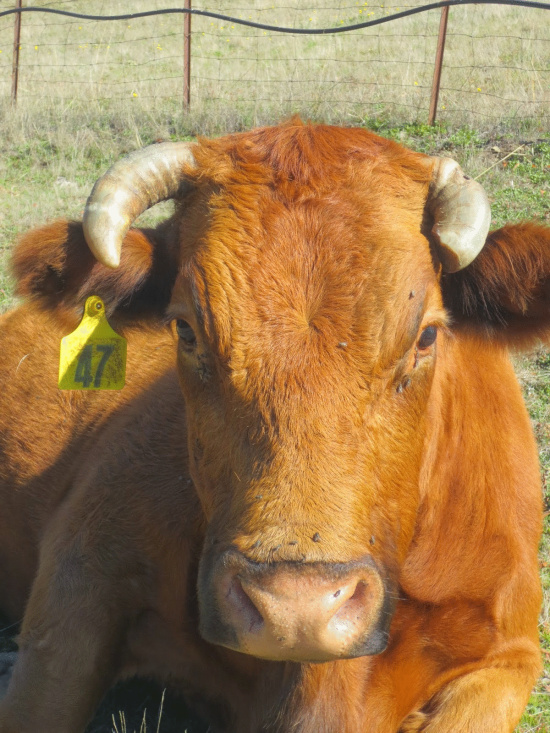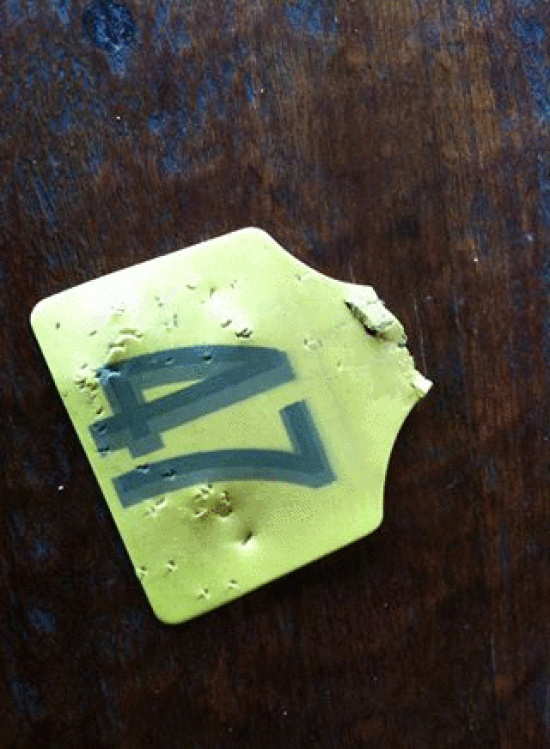Lakia meditating on her ranch.
Cow number 47 was killed this week. A pack of dogs trespassing on the ranch where she was lead cow tore her apart. A few days later, the ranch bull was attacked by an entirely different pack of canines and injured. Free-roaming dogs have always been a problem for stock owners. The ranchers wish pet owners understood that not only could their dogs be harassing wildlife or livestock while out running but, if their pets attack someone’s livestock, they may not come home. In addition, the dog owners could become liable for thousands of dollars in damages.
Unlike many ranch animals, cow number 47 had a name — Lakia. She was unusual, too, because, in the bovine world, she was an internet personality — she occasionally appeared on a local blog written by her owner Tj Chapman.
After her death, Chapman wrote, “Lakia was a bit of a pet… She knew her name and came when called and was the leader of her little herd.” Chapman’s husband, Mark, described the cow as bossy but a good mother who took care of her calf and protected her fellow cattle.
Tj and Mark Chapman run a ranch west of Miranda. On November 6, Mark Chapman found Lakia freshly killed and being chewed on by eight dogs. Her calf had disappeared. The pack of attacking dogs initially scattered but two came back.
He grabbed his rifle and shot two of the dogs that had headed back to the cow…. Lakia’s ears and tail were chewed off and she was covered in bite marks that were oozing blood. Approximately 15 feet above where she lay the ground was churned up in a circle and you could see where she had slid down the slope. It was a grisly scene.
Ear tag salvaged from Lakia’s carcass shows bite marks from the dogs.
A dog lover, Chapman was saddened by having to kill the two animals. “Over the years, I’ve caught a few dogs running [on the ranch] and called their owners,” he said. This time, though, he felt he had no choice but to destroy the animals.
Because the dogs didn’t have collars, it is possible the animals were wild, he said. But, “they aren’t skinny,” he pointed out. “They are plump, filled-out, healthy dogs.” He wishes the owners had kept their animals at home so he didn’t have to execute their pets.
It is always hard to have an animal die, he said. But Lakia’s death was especially hard. “We know the cow and we’re sad to lose her,” he explained. Plus, they were worried about her calf.
Then, on November 8, Mark Chapman heard dogs barking at his barn. He rushed down and discovered another distinctly different pack of around six dogs — this time with collars — attacking his bull. These were mostly pitbull and mastiff types while the earlier attackers had been mainly black and white Great Dane types. He was in time to chase them away (he thinks he wounded one) and his bull was still alive.
“The bull’s ears are all chewed and [there’s] some hindquarter bites,” Tj Chapman explained. “He’s one pissed bull.”
Beyond the loss or injury of a loved animal, there’s what Tj Chapman calls “the money thing.” The Chapman’s sell firewood and beef as well as run cattle to pay the bills. Each of their cows or bulls are worth thousands of dollars. Economically, the loss of even one animal eats into their profit margins.
In addition, though the Chapmans’ were delighted to find Lakia’s calf soon after her mother was killed, they will have to hand feed her which adds work to their busy schedules—though, as animal lovers, the Chapmans make the work seem like pleasure. ”[S]he’s now added to my menagerie in our house barn. I’ve named her Kia after her mom and I’ll raise her to be her mom’s replacement,” Chapman said.
Sgt. Ernie Stewart of the Humboldt County Animal Control Office explained that his department gets “two to four complaints per month” of dogs attacking livestock. But he thinks that dogs damage ranch animals more frequently than that. “I think a lot of livestock owners take care of the problem themselves and don’t bother to call us,” he said. He explained that for the 20 years he has worked for the Sheriff’s Department, dogs attacking livestock have been an ongoing problem though he hasn’t noticed the number rising lately.
According to Stewart, county law states that a dog must be “attacking or harassing” livestock before it is legal to kill it. However, he said, “a lot of livestock owners see a dog on their land they just assume that it will be a problem and shoot.”
Dogs, Stewart said, must be kept on a leash or under the owner’s control. If they are running off their property and out of sight of their owner, they are subject to being captured and placed in the Humboldt County Animal Shelter.
Stewart explained that his officers try to respond to complaints about dogs packing and running but “it is a large county. There are only three [animal control] officers for the whole place.” Officers could take several hours to show up on remote properties. This means that livestock owners can get frustrated and eventually deal with dog packs themselves.
If the dogs kill livestock, Stewart said, then the livestock owner can sue the owner to try and recoup some of his or her losses.
Tj Chapman wants to educate dog owners. She wrote on her blog, “Animals die when dog’s run free. We now have a fresh grave with 2 dogs and one cow. It’s not that only bad dogs or unloving dogs, or dogs trained to kill [that] do damage, all dogs loose will form a pack and chase, circle up and kill.”
It’s not just livestock, she says, but wildlife that suffer. “Take a pack of big dogs and even a 1000 pound cow is fair game. Bears are fair game, wild pigs are fair game, deer are fair game, etc.”
She worries that the consequences of dogs learning to run with a pack and kill other animals could be dire. “I’ve even been told children are fair game and I know I haven’t felt safe going on my jogs and walks around the ranch. A pack of 100 pound dogs is a scary thing.”
She’s asking everyone to “get the word out that we have a dog problem. We are hoping that some folks just don’t realize what their dogs can do. We are hoping education can stop this problem and until then we are keeping our windows open so we can hear the ‘yip, yip, yip’ of a pack of dogs on their prey.”


CLICK TO MANAGE